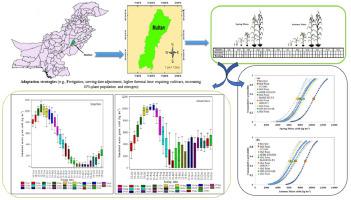Agricultural and Forest Meteorology ( IF 5.6 ) Pub Date : 2023-08-21 , DOI: 10.1016/j.agrformet.2023.109674 Ghulam Abbas , Mukhtar Ahmed , Zartash Fatima , Sajjad Hussain , Ahmed M.S. Kheir , Sezai Ercişli , Shakeel Ahmad

|
Climate change is showing detrimental effect on crop productivity and food security. Adaptive strategies should be implemented to offset the negative impacts of climate change on the maize crop. There is concern that food insecurity will increase in Pakistan due to climate change. Hence, present study was conducted to quantify the response of maize yield to projected climate change and suggest adaptation options i.e., planting date, fertilizer use, fertigation, plant density and hybrid choice to counterbalance the impact of climate change using the CSM_CERES_Maize model. Field data obtained during spring and autumn seasons of 2016 was used to calibrate the model while evaluation was done using experimental data of 2016 and 2017. Afterwards, sensitivity analysis for carbon dioxide, temperature, water, and nitrogen (CTWN) variation was performed, and it was then applied to determine the impact of climate change on spring and autumn maize for mid-century. The results revealed that model performance was better for the spring season than for the autumn season. The model was sensitive to CTWN during the spring and autumn season of maize. Results showed that without adaptation, grain yield will be reduced in the spring (17 to 29%) and autumn (19 to 33%) seasons maize while adoption of adaptation strategies (e.g., Fertigation, sowing date adjustment (earlier sowing of spring maize by 15 days and delayed sowing of autumn maize by 20 days), higher thermal time requiring cultivars, increasing 10% plant population and 25 kg N ha−1 during mid-century) could increase grain yield during both seasons. Therefore, farmers should adopt these adaptation strategies so that negative impact of climate on maize yield could be reduced.
中文翻译:

模拟气候变化对半干旱环境下玉米-玉米种植系统的潜在影响并设计适应方案
气候变化正在对作物生产力和粮食安全产生不利影响。应实施适应性战略,以抵消气候变化对玉米作物的负面影响。人们担心气候变化将加剧巴基斯坦的粮食不安全状况。因此,本研究旨在量化玉米产量对预计气候变化的响应,并提出适应方案,即种植日期、肥料使用、灌溉施肥、植物密度和杂交选择,以使用 CSM_CERES_Maize 模型抵消气候变化的影响。利用2016年春秋季节的现场数据对模型进行了标定,并利用2016年和2017年的实验数据进行了评估。随后对二氧化碳、温度、水和氮(CTWN)变化进行了敏感性分析,然后将其用于确定本世纪中叶气候变化对春秋玉米的影响。结果显示,模型在春季的表现优于秋季。该模型在玉米春秋两季对CTWN敏感。结果表明,如果不采取适应措施,春玉米(17%至29%)和秋玉米(19%至33%)的粮食产量将减少,而采取适应策略(例如施肥,调整播期(提前播种春玉米) 15 天,秋玉米推迟播种 20 天),需要更长的热时间栽培品种,增加 10% 的植株数量和 25 千克氮肥 结果显示,模型在春季的表现优于秋季。该模型在玉米春秋两季对CTWN敏感。结果表明,如果不采取适应措施,春玉米(17%至29%)和秋玉米(19%至33%)的粮食产量将减少,而采取适应策略(例如施肥,调整播期(提前播种春玉米) 15 天,秋玉米推迟播种 20 天),需要更长的热时间栽培品种,增加 10% 的植株数量和 25 千克氮肥 结果显示,模型在春季的表现优于秋季。该模型在玉米春秋两季对CTWN敏感。结果表明,如果不采取适应措施,春玉米(17%至29%)和秋玉米(19%至33%)的粮食产量将减少,而采取适应策略(例如施肥,调整播期(提前播种春玉米) 15 天,秋玉米推迟播种 20 天),需要更长的热时间栽培品种,增加 10% 的植株数量和 25 千克氮肥-1在本世纪中叶)可以增加两个季节的粮食产量。因此,农民应采取这些适应策略,以减少气候对玉米产量的负面影响。













































 京公网安备 11010802027423号
京公网安备 11010802027423号